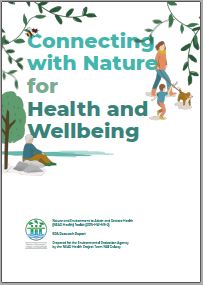Research 348 Toolkit: Connecting with Nature for Health and Wellbeing
Authors: Caitríona Carlin, Gesche Kindermann, Easkey Britton, Martin Cormican, Christine Domegan, Mike Gormally and Diarmuid O’Donovan
Summary: This toolkit accompanies EPA Research Report 348: Nature and Environment to Attain and Restore Health (NEAR Health)

Project Highlights
Watch the NEAR Health project highlights video
The Nature and Environment to Attain and Restore Health (NEAR Health) project was jointly funded by the Environmental Protection Agency and Health Service Executive to investigate how nature and the environment can help society to attain and restore health. The NEAR Health project team combined environmental, health, social innovation and medical fields to build capacity and develop and transform knowledge for communities, policymakers and practitioners. This project investigated (1) how people value and experience nature, health and wellbeing, (2) the barriers and bridges to nature connection, (3) what people want from their healthy future environment and (4) nature- based activities to benefit people’s health and wellbeing. In doing so, the team collaborated with communities to co-create the outcomes of this research.
Identifying Pressures
There is a global biodiversity and climate crisis, and we are witnessing unprecedented declines in species and habitats, many of which inhabit or shape what we perceive the natural environment to be. Building on this, NEAR Health, working with communities of place and practice, identified a “wicked problem” in relation to nature connections, sustainable use and care for nature. People’s connections with nature are related to environmental quality, as litter and neglected facilities were recognised as barriers or disincentives. Therefore, the quality of blue and green spaces and how they are managed strongly influences people’s choices to spend time in them. Aligned with this, although people may recognise that “we are part of nature and we need nature to be healthy,” not everyone has equal access and opportunity to engage with healthy, outdoor environments or blue (water) and green (land) spaces. The research highlights the value of investing in and planning for greater access and use of biodiverse outdoor public spaces, especially coastal and urban spaces, in a responsible, ethical and sustainable way.
Informing Policy
The NEAR Health project demonstrates to state agencies, regulators and policymakers the role of blue and green spaces to enhance ecosystem and human health and resilience. While some of this is now embedded within the National Planning Framework, NEAR Health findings can further assist the implementation of its Sustainable Communities theme. Communities can use the healthy future framework, which includes action plans that are closely linked to sustainable living. This will also support communities to make transformative changes following the COVID-19 pandemic and adapt to climate change. The findings have direct relevance for Target 3.1 of the National Biodiversity Action Plan. Nature based activities also contribute to policies such as A Healthy Weight for Ireland: Obesity Policy and Action Plan 2016–2025, the National Physical Activity Plan, Sharing the Vision: A Mental Health Policy for Everyone, Connecting for Life (national suicide strategy), Social Inclusion and Community Activation Programme and the National Countryside Recreation Strategy, including Leave No Trace. Opportunities exist to include citizen science approaches within existing outdoor activities (e.g. to connect the National Physical Activity Plan with monitoring schemes run by the National Biodiversity Data Centre).
Developing Solutions
The NEAR Health project identified solutions regarding people’s values and perceptions about nature and blue and green spaces. Valuing blue and green spaces for their multiple benefits (i.e. social, spiritual, emotional and environmental, as well as economic benefits) is of critical importance. A solution to the “wicked problem” related to nature connections, sustainable use and care for nature lies in participatory practice, whereby participants codesign their solution through backcasting processes. This cultivates community connectedness and promotes sustainable living. Recognising the lack of accessible “how to” guides, a toolkit was created to share ideas and insights, tools, processes and practices for how we might connect individuals and communities with nature to benefit their health and wellbeing. The toolkit highlights (1) how people value and experience nature, health and wellbeing, (2) the barriers and bridges to nature connection, (3) what people want from their healthy future environment and (4) how nature-based activities can benefit people’s health and wellbeing and enable them to develop a deeper connection with their wider community and with nature. Connecting with nature helps people to care more for the environment and promotes positive wellbeing.